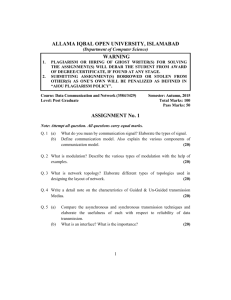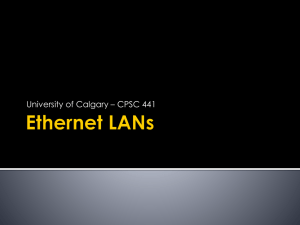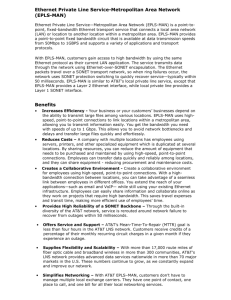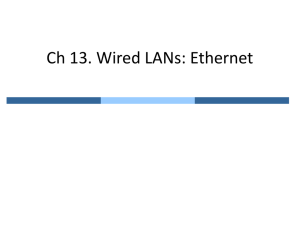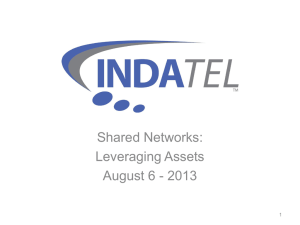204 kB 27th May 2013 Ethernet in enterprise networking
advertisement
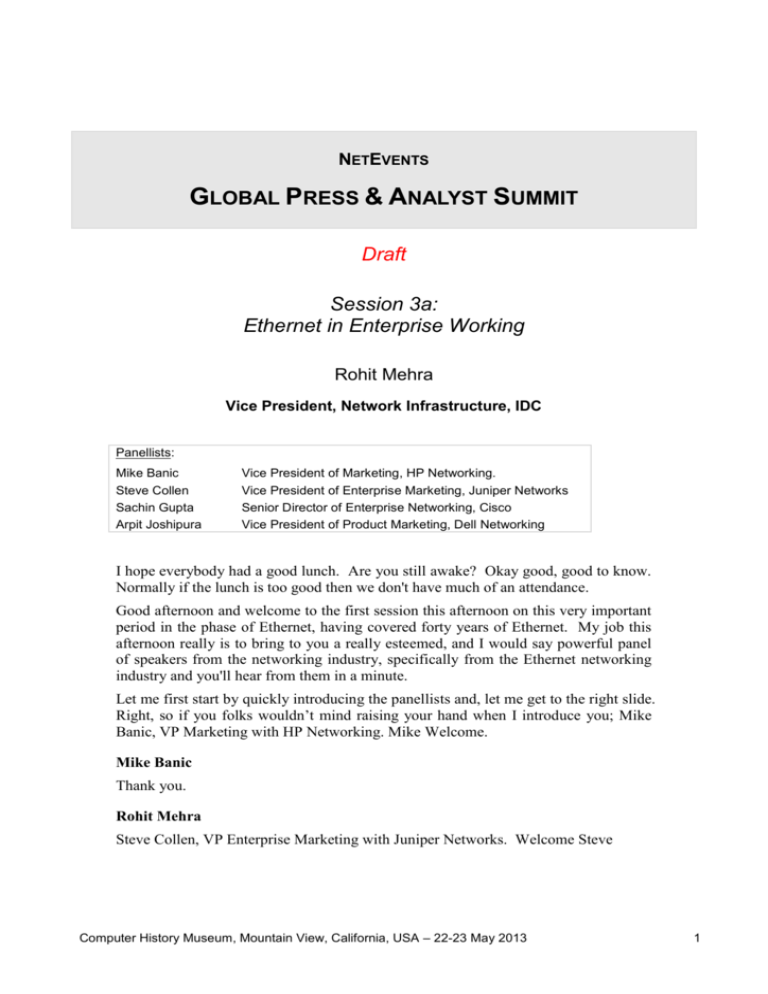
NETEVENTS GLOBAL PRESS & ANALYST SUMMIT Draft Session 3a: Ethernet in Enterprise Working Rohit Mehra Vice President, Network Infrastructure, IDC Panellists: Mike Banic Steve Collen Sachin Gupta Arpit Joshipura Vice President of Marketing, HP Networking. Vice President of Enterprise Marketing, Juniper Networks Senior Director of Enterprise Networking, Cisco Vice President of Product Marketing, Dell Networking I hope everybody had a good lunch. Are you still awake? Okay good, good to know. Normally if the lunch is too good then we don't have much of an attendance. Good afternoon and welcome to the first session this afternoon on this very important period in the phase of Ethernet, having covered forty years of Ethernet. My job this afternoon really is to bring to you a really esteemed, and I would say powerful panel of speakers from the networking industry, specifically from the Ethernet networking industry and you'll hear from them in a minute. Let me first start by quickly introducing the panellists and, let me get to the right slide. Right, so if you folks wouldn’t mind raising your hand when I introduce you; Mike Banic, VP Marketing with HP Networking. Mike Welcome. Mike Banic Thank you. Rohit Mehra Steve Collen, VP Enterprise Marketing with Juniper Networks. Welcome Steve Computer History Museum, Mountain View, California, USA – 22-23 May 2013 1 Global Press & Analyst Summit NetEvents Steve Collen Thank you. Rohit Mehra Sachin Gupta, Senior Director, Enterprise Networking, Cisco, welcome Sachin, and Arpit Joshipura, VP, Product Management and Marketing, Dell Networking, and we know Arpit that you come from Force10 where you had senior product management and marketing rolls. Welcome. Arpit Joshipura Thanks. Rohit Mehra So without further ado, I know we have a very short capsule of a window to get our message out in terms of where Ethernet fits within enterprise networking, so I'll just get started. I'll spend just a few minutes providing my perspective on the Ethernet market itself and where it's come from and where it's going and then we'll get right into the panel. Then at the end, like some of the other sessions, we'll try and keep some time for you for audience Q&A just to make it interesting, just in case these folks have not provided you with enough of a debate, enough fodder if you will, for you, to make this interesting. So very quickly, where is the Ethernet today? If you see, the broader enterprise market in 2013 is at $42.4billion for IDC's forecast and that includes all enterprise networking technologies combined. You can see from this slide that on the right the table tells you what are the various technologies that are included with enterprise networking. The key aspect of this that I do want to point out is, Ethernet is a core technology for each of one these enterprise networking technologies, so much so that it garners nearly 47% share of the broader worldwide networking market. In fact some of the other adjacent technologies you might even consider them layered on top of Ethernet, for example, Wireless LAN, we all look and live our lives with Wi-Fi today which certainly rides on top of Ethernet, I would call it sister technology. But nevertheless, the point is that Ethernet is a core technology, just Layer 2/3 Ethernet is a core technology almost to all enterprise [shelves] today. Having looked at 2013 I want to actually walk you through a little bit of memory lane. I don't have forty years of history here but I do want to share with you, I think we've got data from 1995, so it's surprising that we've still got it. This is end user spending on Ethernet from 1995 to date, to 2013. You'll see this market has grown in terms of users, end users and IT managers, network managers, spending on that infrastructure and how that market has grown. You'll see a few bumps along the way but generally it's been a great ride for the last twenty-five years or so that we've been able to measure it. Computer History Museum, Mountain View, California, USA – 22-23 May 2013 2 Global Press & Analyst Summit NetEvents The next part I want to talk about is look at the Ethernet by speed, I thought you might find this data very interesting as well. The red line is Gigabit Ethernet that we all know, that's been the backbone of the enterprise networks, especially larger enterprise networks for many years. In that market, again, you'll see a little bit of a bump in 2009, largely macroeconomic issues but it held its course. The blue line going up all the way it 10-Gig, no question that 10-Gig will actually, we expect at IDC that it will take over by 2016, actually that will be a market size larger than Gigabit Ethernet. You also see at the bottom right 40-Gig as well, ramping literally like a hockey stick. So that's what are the speeds and feeds. I also wanted to segment the market for you in terms of datacentre versus nondatacentre. So the yellow line is datacentre, no question, we know that's the heart growing market for Ethernet and largely driven by 10-Gig and 40-Gig of late, growing very, very fast. The one in red though is Campus Ethernet largely, there's a little bit of service provider but I really wanted to segment datacentre versus non. So actually, yes, it's a relatively flatter line but a significantly higher market than the datacentre market. I know many of us focus these days on and, especially many industry analysts like myself, and we 'Drink our own Kool-Aid' and say 'It's the datacentre to focus on' but let's not forget the campus. The next piece that I want to talk about really is what's happening with network workloads, at the end of the day they will determine where we find value in the Ethernet. I've got a long laundry list here, I don't want to go into each one of these, but I want to basically share that these are some of the workloads that we see and end users and IT managers being most concerned about. Some are concerned more about videos, some might be concerned about the virtual desktop, others might be concerned more about security, but at the end of the day they are thinking in terms of the network, specifically the Layer 2/3 network and finding ways to evangelise and make it work for the needs of the business. The linkage between your business applications and the Ethernet network has never been greater and that's what is driving what's happening today. So without further ado let me move to the topics for discussions that we as a panel will walk through over the network twenty minutes. Are you guys ready for some rapid fire questions guys? Mike Banic Absolutely. Steve Collen Sure Rohit Mehra Great, we're looking forward to it and I'm sure the audience can't wait to get your views on some of these. So I personally, I have the honour of having picked some of the topics, the speakers have not seen these before, I will vouch for that. I thought Computer History Museum, Mountain View, California, USA – 22-23 May 2013 3 Global Press & Analyst Summit NetEvents some of these topics were going to be of primary interest to many of us, looking at where are we today with Ethernet in the enterprise and where are we going. So we'll try and address it to some extent where we are go today, status quo, but really where we're going. So let me start first with the Mobile Edge. We know BYOD has been a hot topic, becoming in the last few years, so where exactly to the lines of mobility and Ethernet, your wired network, where do they intersect and where is that going? Who wants to start? Okay Steve. Steven Collen I'll say that they intersect at the management layer. So I think the key criteria moving forward is a management platform that can handle both wired and wireless infrastructures. That single pane of glass will be a definer in the marketplace. Now I think it's interesting to consider, however, who will provide that management interface. Will it be vendors like us or will it be cloud-based provided by some other kind of service provider? Rohit Mehra All right. Mike Mike Banic So one of the things I want to touch on is, well first of all, HP provides multi-vendor management for a lot of customers in the enterprise and we do that with products that come out of HP Software, but we also provide a lot of reach management for the network for our own products, and that includes a lot of third party vendor products. One of the things we've learned about BYOD is you can solve a lot of problems for customers quite easily in the network. I agree with Steve, the intersection point is at the management point because things like BOYD and mobility isn't just about the smartphone or the tablet but also about the laptop. So providing that single, consistent policy enforcement based on the identity of the user, regardless of who they connect and wherever they go is important, and sorting out problems that right now would be solved with things like mobile device management in that single pane of glass, can bring about a greater economic benefit. It brings about simplification and that's really the core of our strategy at HP. Rohit Mehra All right. Arpit. Arpit Joshipura Yes, so I think the problem on the question you've framed was BOYD and how should we look at it, right? So we look at from three perspectives; the 'D' part of it, the devices first. I agree with Mike it's not just phones it's tablets and anything you can bring. Not only that, it's moving to VDIs and thin clients and you've got to Computer History Museum, Mountain View, California, USA – 22-23 May 2013 4 Global Press & Analyst Summit NetEvents manage the entire inventory of what anybody brings, so that's the first problem to be solved. The second problem to be solved is not only is there multiplicity of devices but there is the throughput going up per device. So with the 802.11ac coming later this year [and indeed] to a desktop, the access of the enterprise or the desktop or the device is probably Gig which means there's a Gig of throughput coming in and then depending on the over subscription and all that you've got the Campus core. So that's the second problem. Then I think the third one, which is the architecture, how do you fit it altogether? So I agree that there's a management intersection but I don't agree that we have solved the problem as an industry. Wireless networks are still an overlay on the Ethernet, yes, bits will be transported at the fastest, lowest cost, hit the ground as soon as possible, but will not solve it. Rohit Mehra Thanks. I think Sachin -Sachin Gupta So if I can just add to that, so I think management is critical but I don't agree that wireless is still an overlay. So I think you have to treat, if the Mobile Edge is real you have to offer the same experience over wired and wireless, so treating it as an overlay just does not work, especially with 11ac now shipping from Cisco and providing Gigabit access over a wireless network. You have to terminate wireless at that first switch, you have to think about quality of service. When we brought Voice to the network we thought at resiliency, with PoE, we thought about quality of service. If you're going to move to a Mobile Edge, yes you need unified access, you need one management, you need one policy across wired and wireless, you also need to have one network that can deliver all the key OS control and security that you're expecting to offer that consistent user experience. Rohit Mehra I happen to know these speakers personally as well and I have to admit I was wondering before we started the panel would they be ever in a position to debate but, as you can see, there is some healthy debate going on here. I'm glad to see that. All right, so we've talked about the Mobile Edge. In the interests of time let's look at the opposite end of the spectrum if you will, let's talk about the datacentre. Where are we with Ethernet in the datacentre today and what problems have we addressed and what are some of the frontiers from a datacentre and Ethernet standpoint? I think Arpit you are raring to go. Arpit Joshipura Yes, I can go. So I think datacentre architectures historically have been set up based on older workloads that were predictable; exchange, SAP, whatever. The IT admin Computer History Museum, Mountain View, California, USA – 22-23 May 2013 5 Global Press & Analyst Summit NetEvents new exactly how to architecture the datacentre. The newer workloads, the web workloads with memcache or storage replications, VDI, (inaudible), you name it, they're unpredictable, specifically around even VMs and VMs moving around and server virtualization. When you don't have a predicable workload in a datacentre your architecture needs to be flexible and I think this is what is the heart of the problem today where instead of , you know, if I need to go to a person next to me in a hotel room on the same floor, why go down to the receptionist to find out he's on the same floor? That's what today's architecture is, you're going all the way to the core aggregating versus distributing your switching and networking close to the VMs as close to the servers as possible. So I think this is where it's heading and then, of course, we'll all [technical difficulty] 3-Gig, 10-Gig, all those things I don't things, I don't think we need to debate that, I think we'll all --. Rohit Mehra Are you saying it's the capacity and the performance issues are taken for granted and we need to be --? Arpit Joshipura Taken for granted. Latency, performance, throughput, that's a given. Rohit Mehra Okay, who wants to take him on? Mike Banic I want to take a completely take on this which is, today the administrative expense in networking is really high, it's much higher than the cost of acquiring the actual infrastructure, because it's all done by people. Just like there's Metcalfe's Law, there's also Moore's Law and we know that computers and everything else are going to get twice as fast and cost half as much in the future, but the people who are doing all the administrative work, they're going to have salary and that goes up with inflation every year. But if we can automate things we actually eliminate a lot of that and there is some pretty cool stuff that we've actually demonstrated and we've filed patents on that do that today, and they do that for traditional network kit and sometimes it doesn’t have to be HPs, which ensures our customers have choice and flexibility. So these technology virtual application networks allows you to then start treating the network as though it's a set of pooled resources. You define what you need for an application and it will automate the configuration of those resources; access switches, core switches, routers, firewalls, IPSs, and it will actually evaluate whether those services are there in place before you hit the 'Go' button to deploy them, so that you know that the reliability is there, that you can actually get the amount of bandwidth you need from the access layer or from the core layer or you can get the firewall services you need, and it takes that human middleware out. Our technology services Computer History Museum, Mountain View, California, USA – 22-23 May 2013 6 Global Press & Analyst Summit NetEvents people who stand up at instances of exchange for clients around the world all the time, tell us to just deploy exchange, very basic instance of exchange, minimum two weeks, that's the time, the human middleware factor. That's very concrete. They've taken this technology and they've filed patents because they have seen it go to five minutes and deprovisioning in seven minutes and that's an innovation on top of Ethernet that will give great value to customers. Rohit Mehra Steve, what's Juniper's view on where's the datacentre going vis-à-vis Ethernet? Steve Collen Well I'm going to disagree with both of the other speakers, actually I'm not but I felt like I had to say that. So I think that we are in the middle of a war of bandwidth, density and scale and that war shows no signs of decreasing. I think, however, that the war will be won, again, at the management layer. Now we see many claims of huge network scale, hundreds and thousands of servers, but the key question for me is actually how you make those deployable in a way that's easy to use, easy to manage, easy to deploy for the customer. So that, for me, is really where the war is being fought. Now I did like the recent announcement from HP showing how they reduced from hours to minutes the configuration task by moving from the CLI to automated configuration, so that's good. The CLI is not an interface to use and so I applaud that move, so the war will be fought on the -- and that was a joke -- the war will be fought on the management layer. Rohit Mehra All right. Sachin. Sachin Gupta So, I agree the management layer is important but there is innovations at just the Ethernet level that have been critical and it is not a one-size-fits-all. So we find in the datacentre you have low latency requirements or high frequency trading and if you innovate in silicon like we have at Cisco we're able to bring that down to a couple of hundred nanoseconds in terms of capability to forward. If you think about creating overlay networks you can innovate with OTV technology to create overlays, stitch together datacentres, you can provide location independence with LISP to make sure that the VM mobility that was being referred to before can be simplified. So we find that yes, speeds and feeds will take their course depending on cost and power, probably two of the bigger drivers, but there's additional innovation that can be brought to the table to enable some of the trends that we're seeing in the datacentre. Computer History Museum, Mountain View, California, USA – 22-23 May 2013 7 Global Press & Analyst Summit NetEvents Rohit Mehra Excellent, well put guys, we really appreciate your candid comments. Let me now, we've talked about two silos, both ends of the spectrum; the Mobile Edge in the enterprise network and we've talked about what's happening at the core and the datacentre. Let me throw a little bit of a curve ball and talk about a topic that's near and dear to many of us in the industry called virtualization. A very open-ended word and I purposely have brought it into this discussion because there are differing views on how virtualization will impact networking. It has impacted servers, the compute function, it has impacted the storage world as well and, as you can see it, we also have, we live in a world where IT talks about desktop virtualization, they talk about application virtualization and we live in a mobile world, you want to virtualize as much as you can because the power of compute in your hand is so great that you want to be thinking about it in a virtualized manner. All right, so now we've talked about how virtualization will impact network, let me ask the panel, what do you think of how virtualization intersects with networking, intersects with Ethernet and where we do go from here? Who wants to start? All right, Mike. Mike Banic Everyone needs to take a turn at starting, right? So there's a couple of things that Bob said early this morning that made me think about things that we're doing at HP that are very relevant to virtualization and requirements we see customers setting. One thing he said earlier today was about solving the problem of the rat's nest and he also said the rat's nest it back. It's kind of interesting that he said that because I kind of agree and in the datacentre one of the things we've seen with virtualization is, it's actually caused all this additional network connectivity to servers because they're supporting all these different workloads. We separate workloads in the past through physical air gaps and so everybody wants their own port on the server and that becomes untenable at a certain point. So actually dissolving network technology into compute allows you have single big pipes that you then virtualize, you carve out channels that have that true separation, a true air gap but virtually and that eliminates a lot of the rat's nest. You get one cable that, you know, as that server supports different workloads in the future, you don't have to rewire it you just reconfigure it through software. So we do that Virtual Connect FlexFabric. The other thing I'm seeing is just, the virtualization has this new drive on traffic patterns and one of the things that Rohit's been saying is that evidence says that a huge percentage of the communication is actually machine to machine. So I think, Arpit made that point, why go to the front desk when you know what room to go to, just take a direct trip to that floor in the hotel. So this notion of traffic as east to west rather than north to south and doing things to eliminate that latency by making a single big fabric that's Layer 2. That's two things that virtualization has had as an impact on networking. Computer History Museum, Mountain View, California, USA – 22-23 May 2013 8 Global Press & Analyst Summit NetEvents Rohit Mehra All right, Steve do you want to --?. Steve Collen Sure. So to cut a long story short, the network has been getting in the way of virtualization, so we have to make the network invisible. That's certainly an interesting concept but I think even more interesting is how virtualization is affecting the purchasing behaviour and the decision-making group inside the datacentre. The networking team is in danger of becoming irrelevant, all of those Cisco CCIEs, sorry, their jobs are at risks. So we have to really, as networking vendors, make the network relevant again but at the same time making it invisible and at the same time as that make it something that this new and emerging DevOps team actually cares about. So it's a multifaceted problem that we as a group have to address. Rohit Mehra Okay, Sachin. Sachin Gupta So I actually think the CCIEs, that career path is flourishing, I'm a CCIE myself. Now with the virtualization you have to understand there's multiple faces to virtualization and we've touched on some of the aspect in datacentre. Again, this is an opportunity innovate, so if you you've got virtualization happening in the Campus, you can think about how you segment user groups, you can think about how you carry the rich context that BYOD provides at the access switch and use some sort of group tagging mechanism to create that with the network. You can think about virtual desktops and how the traffic patterns change for that, how do you insert realtime media and allow voice and video collaborating with the virtual desktops to actually work. Again, in the datacentre through innovations where we can provide location independence, we can provide overlay networks and virtualization through that, we can innovate so that we allow consolidation and provide simplicity with virtualization with multiple faces. Arpit Joshipura So I think my view is slightly different here which is, where CCIE is relevant or not, whether CLI is the way of the future or not, that's TBD. I think the most important thing is the requirements on networks just got even harder. With all the virtualization, based on some of our modelling, we're getting to 25x today's bandwidth per rack. So someone's got to switch and route and forward that traffic, so it's a big problem. Secondly, as I said, east/west traffic, server-to-server, all these new workloads, tremendous amount of traffic and architecturally I don't want to go up and build new networks based on all the thinking of core and aggregation and top-of-rack and blade and servers and storage and things like that. As an admin I want to look at new Computer History Museum, Mountain View, California, USA – 22-23 May 2013 9 Global Press & Analyst Summit NetEvents technologies that push switching down to the servers, put it close to workloads, optimize the architecture for the specific workloads, a whole brand new set of technologies in switching is available, and by-the-way they're all being presented in a server language okay? [GWI], Point and Click, Perl, Python Scripting, I was excited that Bob is taking that course for, you know, it's not a CLI world anymore, let's face it. But the role of network does not diminish. Rohit Mehra Great, thank you for your insights. I also have to commend the panel, we've gone about twenty, twenty-five minutes and no-one yet has uttered the word 'SDN' believer it to not, that's great, thank you. Arpit Joshipura That's tomorrow. Rohit Mehra We've reserved that for tomorrow and we agreed as a panel in our prep meet that we're going to make sure we, so since we are not talking about SDN let's talk about network virtualization. Let me throw this out to you guys. Mike Banic You're getting really close there. Rohit Mehra We're close, we're playing with words here. I've seen incarnations of solutions that IT is looking at, some of it is calling it Network-as-a-Service, that you can use, different folks use different jargon, but at the end of the day it's some kind of as-a-Service, ITas-a-Service or you can call it cloud-based service, but it does pertain to networking. So I'm not sure if the audience yet can draw the connection between Network-as-aService and what does it have to do with the Ethernet, and maybe it doesn’t. If you might want to take maybe sixty seconds each and just give us your view. Where does this fit in the broader enterprise networking domain? Arpit Joshipura Yes, so I think the way we look at it at Dell is it is not about the networking function here, it is blending the line between server storage and networking software and applications in the datacentre, outside the datacentre, all the way to the clients, then the devices and the media. That is, you've got to package it all and then, of course, you peel out infrastructure as a service, just separating out network and just saying 'I'll give you a few of these, the VM-type concepts on switching'. That's not how we look at it, it's a full end-to-end IT view storage, server, networking, software solutions. Computer History Museum, Mountain View, California, USA – 22-23 May 2013 10 Global Press & Analyst Summit NetEvents Rohit Mehra All right, how wants to take a --? Sachin Gupta I think where we may be seeing some of this is, when you have IT departments that are really acting like a service provider, so they're offering network services, they're offering datacentre services for different departments and must be able to carve out resources and have some elasticity in their ability to do this. So you do need to worry out network virtualization, you need to think about how you enable different VMs, how you move VMs, how you provide them on demand. Then I think the point that was being made earlier about how do you manage this so that carving and management of these resources by department is simplified. So I think those are some of the examples that we see and some of the innovations that are talked about really help IT deliver as a service provider internally. Rohit Mehra Let me, I know we have literally five minutes left before we open it up to at least a few audience questions and I want to get some questions for sure. So let me talk to each one of your guys and start with maybe Mike, just take ninety seconds and give us your view of where you and HP see the networking industry as a whole going and what some of the challenges might be. Mike Banic So I was actually going to say something about Network-as-a-Service because I thought we were all going to do that. I'll weave the two together. Rohit Mehra Well yes, thirty seconds on the first one if you have a point, sure. Mike Banic Yes, I'll gladly do that. There are two things. Whenever we talk to somebody we always hear two different points of view around Network-as-a-Service, one is, is it a business model and how do I want to use it as an enterprise? From the business model perspective and a lot of times what it's important to is the server provider who is oftentimes delivering these managed services to their client. On the customer side around how they want to consume things the dialogue is often about 'We don't have any IT staff anymore.' We talked to one of the world's largest entertainment companies, they have three direct reports who work on their payroll that are responsible for the network and to them they rely on their service provider. So we actually devised a model that allows for providers to deliver any kind of a solution, whether it's datacentre, campus or branch with our broad range of portfolio, but in a unique way that allows them to gain profitability immediately. But it delivers the customer the rich services that they want. Computer History Museum, Mountain View, California, USA – 22-23 May 2013 11 Global Press & Analyst Summit NetEvents Now one of the things that comes really important is 'I need to have the leading edge capability, I need to the network to be connected better to the application.' So the thing I talked about earlier, virtual application networks, is built on our single pane of glass management. So they actually are able to get a network that is dynamically provisionable, remember five minutes to provide services for exchange on a network, that's pretty phenomenal. So those are the kinds of innovations that they see valuable to them that we're enabling a service provider to deliver. Now about HP, I mean I can sum our strategy up in one word and that's simplification. As we think about delivering on that strategy to customers one of the things we think about all the time, which is something Bob mentioned, which helped Ethernet win over Token Ring, and that's focusing on open standards, because that ensures customers have choice flexibility. But the innovations we deliver based on open industry standards focus on really three core values which is, not just to simplify the network but to scale it and to automate it, so that was as customers have more and more devices, as they get more and more endpoints and that are becoming sensors in the network almost, they have something that scales and they can actually administer that in a more automated way, eliminate the human middle ware. Rohit Mehra Right, who wants to go? Steve. Steve Collen I'll try and say that in a punchier why, but I agree with it. The future is all about being open. So if you're a company out there or a networking professional you want to have choice, you want to have flexibility moving forwards. So for me it's all about working with vendors, sorry Cisco, that offer a very open platform that can integrate with anything. So to your point, integration using Chef or Puppet or Python on OpenStack, these are all really, really good things. So I think if we can optimize the underlay, and I'm not going to use the three letters, if we're going to optimize the underlay and at the same time make it an open, optimized environment, then I think everyone will win, except the Cisco, sorry, everyone will win in the customer base. Rohit Mehra So on that note I'll invite Sachin to come and talk to us. Sachin Gupta Thanks Rohit. So I think openness and I think our participation in things like OpenDaylight, our announcement on Cisco 1 architecture, open networking environment architecture, where we're offering a platform to open kit, that supports OpenFlow as well. I think we're pretty clear that we support open standards however we also continue to believe that we need to innovate and so we were the first to bring out Power over Ethernet, drive that to a standard, we brought out Tag Switching and drove MPLS as a standard and so we will continue to do that and offer new Ethernet innovations that we push through the standards bodies. Computer History Museum, Mountain View, California, USA – 22-23 May 2013 12 Global Press & Analyst Summit NetEvents Now having said that, the enterprise networking vision at Cisco is really to enable the 'Internet of Everything'. So we believe we're about connecting people, connecting clouds and connecting things and I do believe that IT is looking for simple, secure ways to do this that help them lower cost of ownership and so our strategy for this is quite simple. We're going to enable this with one management, a single management platform, one policy for wired, wireless, VPN, for your entire access network and one network. There is no overlay we will offer an uncompromised user experience for wired and wireless and as these new types of devices come on board, the new physical surveillance smart grid, the new types of sensors that are coming on, there's going to be new requirements that we will innovate for and drive through standards at Cisco. Rohit Mehra Great. Arpit your ninety seconds. Arpit Joshipura All right, so first of all let me change the topic a little bit because open is like an openended word right? How many of you have attended previous NetEvents, just a show of hands? So for those of you who were in Portugal then you may have heard me say 2012 was the year of 10-Gig. IDC numbers and some of the other analysts numbers show tremendous penetration, we are getting to critical mass and what I'm saying now, from a Dell perspective as well is, this is the year of 40-Gig and this is where we're going to see a lot more throughput coming in. Necessary and I don't have stories from kilobits but I'll tell you one of the stories where we were debugging two years ago, the introduction of 40-Gig technologies and with our partner on the test equipment and we didn't know, because of the lower latency and the speed where the problem was. So I think we're getting to a point where, this is one of my first challenges to the industry that Dell wants to address, is the ecosystem needs to step-up, the Ethernet ecosystem needs to step-up, it's not just about the silicon that goes in it, it's not about the system vendors and the infrastructure that we build, as our peers companies. But the optics, the QSFB+s, the cables, the mix, the test equipment, you name it, those. There will always be a ping-pong effect, so I think we want to make sure that we pull in the ecosystem along with it by being open, by being interoperable, that's the only way we will get to an optimized enterprise, as we call it at Dell. Rohit Mehra Great, thank you. Okay, we are literally out of time so we have a couple of mikes, so if somebody has a question? It looks like Bob has a question. Bob Metcalfe We are honoured to have such four fine companies here with us today. I'd like to ask a sophisticated innovation marketing question, or I hope you take it that way. Around this time of afternoon forty years ago, a brand, Ethernet was typed on a selectric typewriter and there's been some debate about what the word Ethernet means. Does it mean CSMA/CD on thick coax, does it mean the packet format? Ethernet is Computer History Museum, Mountain View, California, USA – 22-23 May 2013 13 Global Press & Analyst Summit NetEvents prominent in the last fifty sentences you all uttered, what does Ethernet mean to you? Why do you use the word Ethernet in your language? What does that word mean now? Mike Banic Well actually a reporter asked me a question this morning and I said to him that for the market as a whole Ethernet represents something of confidence, that was the one word I summed up. I think it was the panel this morning about 'Ethernet or Ethernot' that reminded me of this, that there's been so many challenging technologies over the years and Ethernet has demonstrated such a level of resilience because it's adapted to how people needed to change, to go from shared media to switch media where everybody's dedicated, to be able to move to the airwaves and to move to different physical media and support higher speeds over unshielded twisted pair that people didn't think was possible. It's that adaptability and the adherence to open standards in order to meet the end user needs in the process that it's given people confidence and it's a word, Ethernet is word that just kind of resembles connectivity to everybody. My parents actually know what Ethernet is because the computers I gave them, I went to HP and bought them computers at an employee discount, that's how they connect everything and that's how they understand that and they think that 802.11 is just wireless Ethernet. So it's a ubiquitous word that means 'I'm connected' and the ether kind of gives the notion that it's over any media. Rohit Mehra Okay, anybody else? Arpit Joshipura Yes, so from my perspective, I think it is a powerful brand that has evolved into more a generic statement in marketing. So we don't call, let's say, we don't call PCs 'Intel' but the Intel processor is inside a PC. So that's how we have been using it as a term where you have switches with Ethernet, you've got Layer 2 switches, you've got routers with Ethernet connectivity both at the physical and at the protocol level, you've got test equipment, you've got all these devices. So it kind of implies a bigger thing, for us at least, it's not the specifics of the actual definition you meant, right? Rohit Mehra Right. Do we have any other folks with a question? All right, there's one here in the middle. From the floor It's a cheeky comment not a question, you could call yourselves Ethernet Inside, inside everything. Rohit Mehra Yes. Intel won't like that. Okay. Computer History Museum, Mountain View, California, USA – 22-23 May 2013 14 Global Press & Analyst Summit NetEvents Mike Banic Technically we do at HP by Virtual Connect in a c-Class server, you've got Ethernet Inside. We'll start marketing it that way. Rohit Mehra Yes, I think all of you might want to say there's something inside each of our portfolios but it's a good point and certainly a good branding idea for sure. All right, I think with that, let me close the panel, I want to really thank the panellists for a really, very, very, shall we say, a debate worthy panel, I really appreciate it. Thank you. [End] Computer History Museum, Mountain View, California, USA – 22-23 May 2013 15


